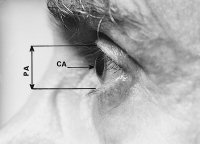When evaluating
corneal apex clearance with RGP lenses designed for reshaping the cornea, as with ortho-k, clearance may be as low as 3-4[micro]m, which is impossible to assess using the conventional method of NaFl alone.
(16) During the second half hour, 365-nm UVA at a dose of 3 mW/c[m.sup.2] or 5.4 J/c[m.sup.2] was applied to the
corneal apex from a distance of 5 cm using a CXL device (PESCHKE Trade CCL-VARIO Cross-linking).
If a patient had a pre-operative refraction, measured in the standard manner (i.e., in the plane of the spectacles, approximately 12 mm from the
corneal apex) of -5.25 Diopters (D), and after refractive surgery is found in emmetropia (that is, with an error of zero D), the method is applied in the following manner:
The measurement points of MCT ([T.sub.m]) are the midpoints of the
corneal apex and the limbus, and the distance between [T.sub.c] and [T.sub.m] is about 3-4 mm.
The densitometry readings at the
corneal apex were used for the statistics.
A superior incision is closer to the
corneal apex than temporal incision.
The geographical center of the subbasal nerve vortex is located between 2.18 and 2.92 mm from the
corneal apex. Near the center of the vortex, the distal segments of the subbasal fibers in some corneas fuse to form an anastomotic network that spirals gently in either a clockwise or counterclockwise direction.
This area provides a relief area for the tissue redistributed from the treatment zone, (30) and is essential for lens centration; if the curve of the reverse zone is too steep, there will be excessive apical clearance, and if it is too flat, the lens will land on the
corneal apex possibly resulting in lens decentration.
The corneal (keratometry, corneal volume, anterior and posterior astigmatism,
corneal apex, and thinnest-point corneal pachymetry) and anterior chamber parameters (anterior chamber depth, anterior chamber volume, and chamber angle) as evaluated by Pentacam are summarized in Tables 2 and 3, respectively.
To do so, we have defined an input plane, tangent to the
corneal apex, and an output one arbitrarily situated behind the cornea.
